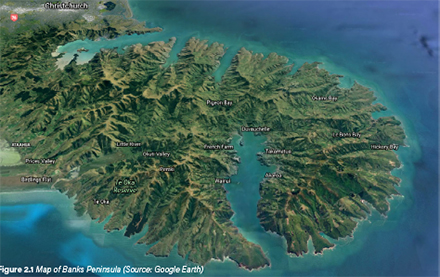In a new report, the Environmental Defence Society (EDS) of New Zealand has called for a reset of government forestry policy to support indigenous forest regeneration on Banks Peninsula and dis-incentivise exotic forestry expansion. Sources: Scoop NZ, Timberbiz
The report is the final in a series of case studies EDS has undertaken as part of a broader investigation into landscape protection in Aotearoa New Zealand.
EDS has already released case study reports on Te Manahuna Mackenzie Basin, Waitākere Ranges, Hauraki Gulf Islands and Tourism.
Co-authored by EDS policy director Raewyn Peart and EDS solicitor Cordelia Woodhouse, Restoring Te Pātaka o Rākaihautū Banks Peninsula investigates the protection and restoration of the Banks Peninsula landscape. It was funded by Environment Canterbury.
“Banks Peninsula is a unique and iconic landscape with its two large ancient volcanic cones, steep and deeply incised slopes and numerous isolated bays. It’s quite different to anywhere else in the country and the world,” said Ms Woodhouse.
“The area has a fascinating history which is closely intertwined with the rise of Ngāi Tahu in the South Island, early encounters between Māori and Europeans, and the formation of New Zealand as a new nation.
“It has also experienced the worst excesses of exploitation, with over 99% of its indigenous forest being removed.
“But nature is making a comeback, with indigenous forest now regenerating on some of the Peninsula’s marginal land,” said Ms Woodhouse.
According to Mrs Peart most land on the Peninsula is used for pastoral farming which is generally of low intensity due to the area’s steep topography and lack of water for irrigation.
“The collapse of wool prices has meant that keeping steep marginal land in production is no longer financially viable in many cases. This creates both an opportunity and a threat for the future of Banks Peninsula’s landscapes,” Mrs Peart said.
“But the full sequestration and other benefits of regenerating indigenous forest are not properly recognised under the system and the applicable rules are clunky and bureaucratic making this option difficult.
“In contrast, the emissions trading scheme, coupled with a now rising price for carbon credits, is creating a strong financial incentive to establish new exotic forestry plantations on the Peninsula.
“It’s a similar story with the government’s One Billion Trees program which has not been well configured to support native regeneration. Two thirds of the direct grant funding on Banks Peninsula has supported exotic tree planting.
“At the same time, the National Environmental Standard for Production Forestry has swept away most council controls on plantation forestry on the Peninsula. It is now permitted as of right in most areas, risking wilding spread, fire proneness and water scarcity as well as significant degradation of the Banks Peninsula’s landscape values.
“Another large loophole in the regulatory framework is the failure of the Canterbury regional policy statement and regional coastal plan to give effect to the New Zealand Coastal Policy Statement, which has been in force now for a decade. We understand work is belatedly underway to address this and it needs to be expedited.
“Nature tourism has the potential to contribute positively to the landscapes of Banks Peninsula. However, prior to Covid-19, large cruise ship tourism overwhelmed the small Akaroa community and its struggling infrastructure. There needs to be a shift towards ‘slow’ tourism that more fully engages with the Peninsula’s extraordinary landscapes.
“The case study highlights the many positive things that are happening on the Peninsula. They include the important role rūnanga have played, as kaitiaki, in restoring the Peninsula’s landscapes both on land and in the sea.
“Charitable entities have also played a strong role in bringing mana whenua, landowners and statutory authorities together to work collaboratively on ambitious landscape-scale conservation projects.
“These positive restoration initiatives need to be supported.
“We have set out a series of recommendations in our report which are designed to influence the forthcoming government reviews of the emissions trading scheme and the National Environmental Standard for Plantation Forestry.
“There is considerable potential to create a thriving, biodiverse and sustainable working landscape on Banks Peninsula that supports mana whenua, the community and nature. But to achieve this, government policy needs to be aligned to this end,” concluded Ms Peart.






